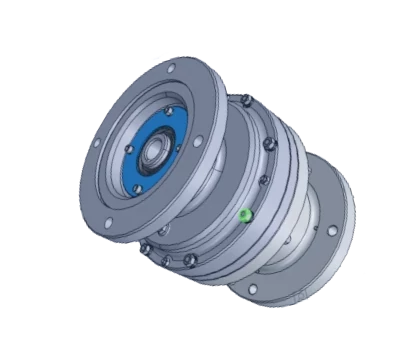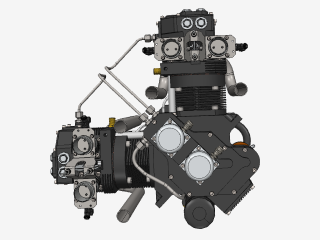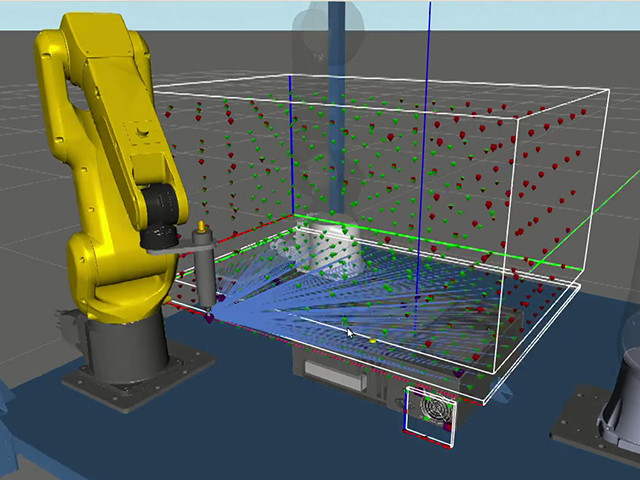

How to convert IGES
to JT?
Applications for end-users. SDK's and tools for software developers. Custom development services for businesses.
Trusted by industry leaders







Available in CAD Exchanger Products
CAD Exchanger Lab
Desktop application to view, explore and convert 3D CAD data across 30+ file formats.
Learn more

IGES
The IGES format was developed to provide a universal standard for exchanging 3D data between different CAD software applications. IGES files, represented in ASCII text, contain information about the geometry, structure, and attributes of 3D objects.
The IGES format enables users to share complex CAD models while preserving the integrity of the data. It supports the representation of both 2D and 3D geometries, allowing for the exchange of points, curves, surfaces, and solids.
Support of IGES in CAD Exchanger
CAD Exchanger can import IGES format files up to version 5.3, export IGES format files version 5.3. Such support includes:
- B-Rep representations;
- assembly structure;
- names;
- user-defined properties;
- colors;
- layers.
Follow this link to check out all the CAD Exchanger products.
Pros of the format
Broad Compatibility
IGES has been a long-standing industry standard for data exchange since its development in the late 1970s. Many CAD systems, both old and new, have built-in support for importing and exporting IGES files. This enables easy collaboration and data sharing between different software platforms, regardless of the specific CAD system being used.
Good capabilities for B-Rep representation
For a format that is over 35 years old, IGES provides good capabilities for representing B-Rep and even representing rigid bodies, including information on connectivity. Combined with the advantages indicated above, it makes the IGES format relevant and actively used to this day.
Cons of the format
Limited representation of B-Rep geometry
The IGES format has some limitations when it comes to fully representing B-Rep geometry. While it can effectively preserve basic geometric information like points, curves, and surfaces, there are difficulties with edge connectivity information. Most CAD writers use the older and limited capabilities of representing B-Rep through bounded and trimmed surface entities. These entities can not contain comprehensive information about the surface topology of bodies. As a result, models written in this form often have inconsistent edge orientations.
No PMI
The IGES format does not have a standardized way to represent or store PMI data. As a result, when exporting a CAD model with PMI to an IGES file, this valuable information is typically lost or not accurately transferred. This limitation can have significant implications for downstream processes, as manufacturers may rely on PMI data for carrying out manufacturing operations, quality control, and documentation.
To overcome the weakness, newer formats, such as STEP, have been developed to support the inclusion and preservation of PMI data. These formats provide dedicated mechanisms to store and communicate PMI information, allowing for a more comprehensive exchange of design intent and manufacturing specifications.
FAQ
Is IGES format specification publicly available?
Yes, it is. The IGES file format specification defines the structure and syntax of IGES files, ensuring consistency and compatibility.
Header section contains general information about the file, such as software details and creation date. Start section defines the units of measurement, coordinate system, and other global parameters. Global section describes the overall structure of the file, including directories, lists, and relationships between entities. Directory section serves as an index for entities, assigning unique numeric identifiers and specifying their location within the file. Parameter data section contains the geometric and topological information of entities. Terminate section marks the end of the file.
What are the IGES file extensions?
The file extensions used for the IGES file format are ".igs" and ".iges". Both extensions are widely recognized and can be used interchangeably to indicate files that conform to the IGES format.
How to open IGES file?
To open an IGES file, you will need a compatible software application such as CAD Exchanger Lab. Start by launching the software and navigate to the 'New file' option. Next, find the IGES file (.igs or .iges) you want to open. Once you've located the file, simply select it and click "Open". The software will then initiate the import process, and once it's complete, the 3D model and its associated data will be loaded into the software. From there, you can easily view and interact with the 3D model.
History of IGES format
The history of the IGES format dates back to the late 1970s when it was developed to address the need for a universal standard for exchanging 3D CAD data. At the time, there was a lack of interoperability between different CAD systems, making it difficult to share and collaborate on designs.
To overcome this challenge, the National Bureau of Standards (now known as the National Institute of Standards and Technology) initiated the development of IGES in collaboration with industry leaders. The goal was to create a format that would allow for the seamless exchange of geometric and topological data between different CAD systems.
In 1980, the first version of the IGES format, known as IGES 1.0, was published. It provided a standardized structure and syntax for representing 3D CAD data, allowing for the transfer of geometric entities, attributes, and relationships. Over the years, subsequent versions were released, introducing enhancements and addressing the evolving needs of the industry. Today, the most widely used version is IGES 5.3, which was released in 1996 and is still in use today.
While newer formats have emerged with improved capabilities, IGES remains relevant, particularly for legacy systems and situations where basic geometric exchange is the primary requirement.
JT
The JT format is a widely used lightweight 3D data format designed for efficient visualization, collaboration, and sharing of complex 3D models and assemblies. JT files retain the fidelity of the original 3D models while minimizing file size, enabling fast loading and efficient data transmission. The format supports features like precise geometry, polygonal meshes, product structure, PMI, and animations.
Support of JT in CAD Exchanger
CAD Exchanger can import files compliant with the JT formats from 8.0 to 10.5 and ISO14306:2012 and export files compliant with the JT formats 9.5 and ISO14306:2012. Such support includes:
- B-Rep representations;
- polygonal representations (incl. multi-LODs);
- assembly structure, including via external files;
- names;
- user-defined and validation properties;
- PMI;
- colors, materials, textures;
- layers.
Follow this link to check out all the CAD Exchanger products.
Pros of the format
Advanced compression and economical data representations
Advanced compression and economical data representations
This file format employs advanced compression techniques to reduce file sizes without compromising the quality of the content. This enables efficient transmission and storage of 3D models and other visual data.
In addition to compression, JT excels in economical data representations. The format is structured in such a way that it is relatively easy to read in a selective manner. Files typically have smaller file sizes than STEP files with comparable geometry. This is achieved by efficiently representing mesh data through topological compression algorithms, which take advantage of the connectedness between mesh patches. Despite the economical representation, JT files maintain their integrity and provide a comprehensive visualization of the original content.
Great meshes support
The format is designed to handle complex 3D mesh data efficiently, making it ideal for applications that require high-quality mesh representation. JT allows for the precise encoding of mesh data, including vertex positions, normals, texture coordinates, and more. It supports both triangular and polygonal meshes, enabling the representation of intricate geometric shapes with smooth surfaces.
Moreover, JT provides robust support for mesh attributes and properties. This means that additional information, such as material properties, colors, and transparency, can be associated with individual mesh elements or the entire mesh.
Cons of the format
Proprietary legacy
While the ISO standardization brought greater openness and interoperability to this format, the legacy of its proprietary history can still be observed in certain cases. It's worth noting that the specifications for JT 7.x and earlier versions were not publicly accessible, and the format was essentially proprietary, so there were difficulties in reading and writing this format in other CAD software. Fortunately, these versions of files are not used much these days.
Implementing full-fledged JT support can be a demanding task. It requires a deep understanding of the intricacies of the format's specifications and algorithms. This can be a barrier for smaller software developers or independent implementers who may not have the resources or expertise to fully grasp and implement the complexities of the format. As a result, the quality of JT support can vary significantly.
Another consequence of the proprietary nature of the JT format is its lack of openness. The latest JT precise geometry representation is based upon the Siemens PARASOLID, which means a high-quality implementation of the format must also be able to read and write this format.
FAQ
Is JT format specification publicly available?
Yes, it is. The JT Open Program, an industry consortium dedicated to promoting the widespread use of JT as a 3D data format, provides the JT file format specification to the public. It offers various resources, including technical documentation, whitepapers, and specifications related to the JT format. These resources can be accessed on the official JT Open Program website.
What are JT file extensions?
The JT format typically uses the file extension ".jt" to denote JT files. It is worth noting that alternative file extensions may also be used in certain cases, depending on the software or system. However, ".jt" remains the most commonly used and recognized extension for JT files across different platforms and applications.
How to open a JT file?
To open this file, you will need a compatible software application, for example, CAD Exchanger Lab. Launch the software and navigate to the 'New file' option. Browse your computer's directories and locate the .jt file you want to open. Then select it and click "Open". Once the import process is complete, the .obj file should be loaded into the software, allowing you to view and interact with the 3D model and associated data.
History of JT format
The JT format, also known as Jupiter Tessellation, has a long history that traces its origins back to the 1990s. It was developed by Engineering Animation Inc., a company specializing in computer graphics and visualization software. EAI created the JT format as a lightweight and versatile solution for visualizing and sharing 3D data in industries such as manufacturing and engineering.
In 2001, EAI was acquired by UGS Corporation, which later became Siemens Digital Industries Software. Siemens recognized the potential of the JT format and continued its development, expanding its capabilities and promoting its adoption in various industries. Over the years, Siemens has worked to enhance the format, improve its compression techniques, and ensure compatibility with a wide range of software applications.
The JT format gained further recognition and acceptance when it was standardized by the International Organization for Standardization in 2012 as ISO 14306. This ISO standardization solidified the JT format's position as a reliable and widely supported file format for 3D visualization and data exchange. Today, the JT format continues to evolve and is utilized by numerous companies and industries worldwide for effective collaboration, efficient data sharing, and immersive 3D visualization.
Convert IGES
to JT
Need to work with CAD files in numerous formats? No worries.
From IGES to JT, CAD Exchanger gets you covered.
What Our Delighted Customers Say
From Our Blog

Everything you need to know about CAD file formats
A CAD file is an output of a CAD software, containing key information about the designed object: its geometry and topology representation, 3D model hierarchy, metadata, and visual attributes depending on the format of the file.
Read more
Realtime Robotics enhances responsive workcell monitoring by reading CAD files with CAD Exchanger
CAD Exchanger enables RapidSense and RapidPlan to read 3D CAD formats thanks to a unified API, fast data processing, adjustable meshing, and cancellation support.
Read more
3D Formats Overview: IGES
We will start a series of a blog posts dedicated to different 3D CAD file formats. We begin with the veteran among CAD data - IGES.
Read more